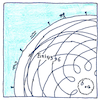Johannes Kepler
astronomy

|
Planetary orbits
Johannes Kepler moved to Prague to work with Tycho Brahe. Brahe gave Kepler his data for the positions of the planet Mars. Ten years later Kepler had figured out planetary orbits. * The planes of the planetary orbits intersect only at the sun. The planets do not orbit at a uniform rate, but at a rate proportional to their distance. The orbit of each planet is an ellipse with the sun at one of its foci, so that a line from the sun to the planet sweeps over equal areas in equal times.
Teachings
Aristotle taught that uniform circular rotations in separate concentric crystalline spheres should explain the motions of the planets. Claudius Ptolemy taught that the earth is the stationary center of the universe around which the moon, the sun, planets, and the stars rotate and that deferents and epicycles could explain anomalies such as retrograde movements. Nicolaus Copernicus taught that all the planets including the earth orbit the sun in perfect circles fixed on transparent rotating spheres. Tycho Brahe taught that the moon and sun orbit the earth but the other planets orbit the sun, all in perfect circles at the center of the perfect sphere of distant stars, and none were fixed on a rotating sphere. The Catholic Church preferred Tycho Brahe’s teaching, considering that 1 Chronicles 16:30 and Psalm 93:1 say that the world cannot be moved. Johannes Kepler used a tool more powerful than telescopes; he used mathematics and found no previous teaching matched the facts.
Foolish bird
Even though Kepler recognized gravity as an “attractive virtue,” he thought that the sun emitted a force that pushed the planets along, and that the planets contained a force that pulled them toward the sun. Realizing that he had first rejected a mathematical definition of an ellipse to describe planetary orbits, Kepler said, “Ah, what a foolish bird I have been!” New things are always easier to understand in retrospect, but a bird cannot fly backward.



Tycho Brahe was the last major observational astronomer to work without a telescope; he used sextants and quadrants. Galileo Galilei introduced telescopes into astronomy in 1610. Johannes Kepler tried to identify causes for his laws of planetary motion but did not have the benefit of the teachings of Galileo or Isaac Newton. Galielo taught why the planets continue to orbit with no force to push them, and Newton taught that gravity explained why orbits are elliptical. Kepler’s idea that the earth attracted the moon like a magnet came from William Gilbert.
See also in The book of science:
Readings in wikipedia: